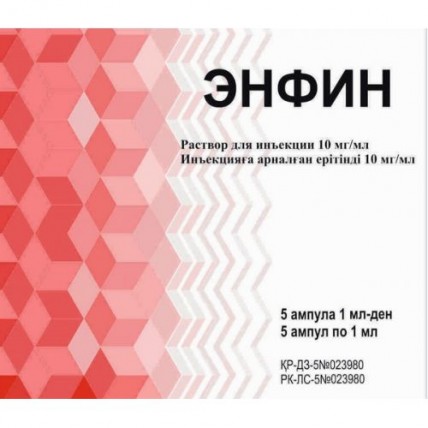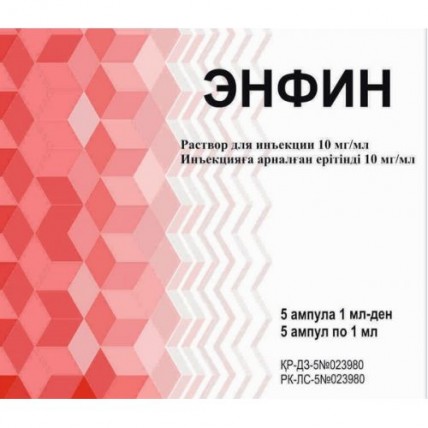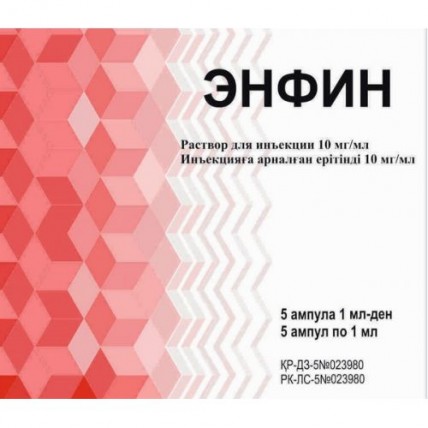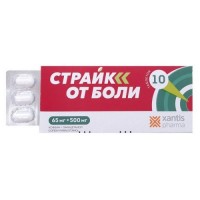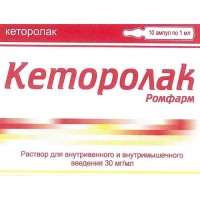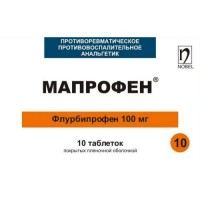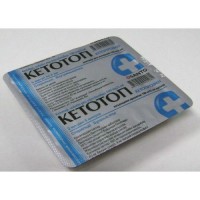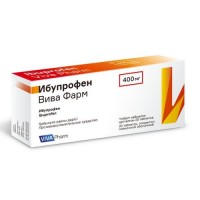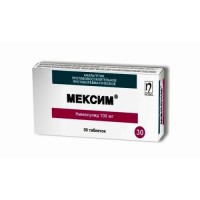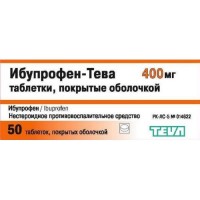Enfin 10 mg / ml 1 ml 5's solution for intravenous administration
- $41.30
Sku:
6e0e067602ce
The instruction for medical use of Enfin Torgovoye medicine a name Enfin Mezhdunarodnoye the unlicensed name Nalbufin Lekarstvennaya a form Solution for injections, 5 mg/ml and 10 mg/ml, 1 ml Structure One ml of solution contains active agent of a nalbufin a hydrochloride - 5 mg and 10 mg, excipients: sodium chloride, sodium citrate, anhydrous citric acid, sodium hydroxide, acid chlorohydrogen, water for injections. Description Transparent, colourless liquid Pharmacotherapeutic group, free from foreign mechanical inclusions, Nervous system. Analgetics. Opioids. Morphine derivatives. Nalbufin. The ATX N02AF02 code the Pharmacological Pharmacokinetics At properties intravenous (in / c) introduction effect develops in 2-3 min., at hypodermic (p / j) or intramuscular (in oil) - in 10-15 min. The maximum effect - in 30-60 min., action duration in the absence of tolerance at p / to or introduction in oil - 3-6 h, in in introduction - 3-4 h. It is metabolized in a liver. It is removed in the form of metabolites with bile, in insignificant quantity — with urine. Gets through a placental barrier, during childbirth can cause respiratory depression in the newborn. It is excreted in breast milk. Elimination half-life — 2.5-3 h. A pharmacodynamics Agonist antagonist of opioid receptors (agonist a kappa - both delta receptors and the antagonist of µ-opioid receptors). Activates an endogenous anti-nociceptive system through a kappa - opiate receptors, breaks mezhneyronalny transfer of painful impulses at the central nervous system various levels. Influencing the highest departments of a brain, changes emotional coloring of pain. Brakes conditioned reflexes, has sedative effect, causes a dysphoria, a miosis, excites the emetic center. To a lesser extent, than morphine, trimeperidine, fentanyl, oppresses a respiratory center and affects motility of a GIT. Does not influence a hemodynamics. The risk of emergence of histamine reaction and also development of accustoming and opioid dependence at controlled use is much lower, than for opioid agonists. Indications - as an additional tool at anesthesia, for preoperative and postoperative anesthesia, for an analgesia in obstetric practice during childbirth - for stopping of a pain syndrome of the moderate and expressed degree of intensity the Route of administration and doses Strictly on doctor's orders. The usual recommended dose for adults makes from 10 to 20 mg for patients with the body weight of 70 kg, everything that is equivalent to 0.1 - 0.3 mg/kg of body weight. The dose can be entered intravenously, intramusculary or subcutaneously, can be repeatedly entered every 4-6 hours. The maximum single dose for adults should not exceed 20 mg (0.3 mg/kg), the maximum daily dose - 2.4 mg/kg. Appointment duration - no more than 3 days. Elderly people the C care appoint to patients of advanced age, it is necessary to appoint drug from minimum effective dose. Children Drug is not recommended to be used to children aged up to 18 years, in connection with limited data on use in pediatrics. Side effects In each group of frequencies the undesirable phenomena are provided as weight reduction. Frequency is classified as: Very often (≥ 1/10), it is frequent (≥ 1/100 to & lt, 1/10), sometimes (≥ 1/1000 to & lt, 1/100), is rare (≥ 1/10,000 to & lt, 1/1000), is very rare (& lt, 1/10000), frequency is unknown (Assessment cannot be defined from available sources) Very often: - sedation Often: - clammy sweat, nausea/vomiting, dizziness / vertigo, dryness in a mouth, a headache Seldom: - the nervousness, a depression, the excited state, crying, euphoria, feeling of an opyaneneniye, hostility, unusual dreams, confusion of consciousness, weakness, hallucinations, a dysphoria, feeling of weight, numbness, pricking, a derealization, depersonalization, nonsense, a dysphoria and hallucinations is, less, than at intake of pentazocine, - a hypertension, hypotonia, bradycardia, tachycardia, - gripes, dyspepsia, bitterness in a mouth, - respiratory depression, short wind, asthma, - an itching, burning, urticaria, - disturbance of the speech, imperative pozyvs to urination, turbidity of sight, hyperaemia and inflows of heat and erubescence. Allergic reactions - after use of a nalbufin it is reported about anaphylactic/anaphylactoid and other serious reactions of hypersensitivity, the immediate supporting treatment can be required. These reactions can include shock, a respiratory distress syndrome, an apnoea, bradycardia, cardiac arrest, hypotension or a laryngeal edema. Some of these allergic reactions can pose hazard to life. Other messages about reactions of allergic type include a stridor, a bronchospasm, rattles, hypostases, rash, an itching, nausea, vomiting, perspiration, weakness and a shiver. Frequency is unknown (assessment cannot be defined from available sources) the Following side reactions were revealed during a usage time of a nalbufin during the post-marketing period with a frequency which it is impossible to define or establish relationship of cause and effect with medicine influence: - an abdominal pain, a hyperthermia, the lowered level or a loss of consciousness, somnolence, a tremor, uneasiness, a fluid lungs, excitement, spasms and reactions in the place of an injection, such as pain, swelled, reddening, burning, and feeling of heat. It was reported about death from heavy allergic treatment responses nalbufiny reported about fruit death when mothers received nalbufin about time of childbirth. The Serotoninovy syndrome - cases of a serotoninovy syndrome, potentially life-threatening state, were reported during simultaneous use of opioids with serotonergic drugs. Adrenal insufficiency - cases of adrenal insufficiency were more often noted at the use of opioids after more than one month of use. Abuse of lekartstvenny means and dependence Nalbufin can become a subject of abuse, dependence and criminal deviations All patients receiving opioids need careful monitoring of signs of abuse and dependence as use of opioid analgetics dependences even bear in themselves risk at the corresponding medical use. Appropriate assessment of the patient, the correct practice of appointment, periodic revaluation of therapy and the correct dosing and storage are appropriate measures which help to limit abuse of opioid drugs. The risks connected with abuse of a nalbufin Abuse nalbufiny are represented by risk of overdose and death. The risk increases at simultaneous abuse of Nalbufin with alcohol and other depressants of the central nervous system. Parenteral abuse of drugs is usually connected with transfer of infectious diseases, such as hepatitis and HIV. Messages about expected side reactions Providing data on expected side reactions of drug is very important point allowing to carry out continuous monitoring of a ratio risk/advantage of medicine. Health workers should provide information on any expected adverse reactions on the contacts specified at the end of the instruction and also through the national system of collection of information. Contraindications - hypersensitivity to drug or any ingredient of drug - the profound respiratory depression and central nervous system - at epidural and spinal anesthesia - a heavy renal and liver failure - an epileptic syndrome, intracranial hypertensia, a craniocereberal injury, acute alcoholic conditions, alcoholic psychosis, acute surgical diseases of abdominal organs (before establishment of the diagnosis), surgeries on a gepatobiliarny system (the spasm of a sphincter of Oddi is possible) - medicinal dependence on morfinopodobny drugs (morphine, Promedolum, fentanyl) — perhaps development of a withdrawal, diarrhea against the background of the psevdomembrazny colitis caused by cephalosporins, linkozamina, penicillin, toxic dyspepsia - with care: advanced age, a cachexia, a liver and renal failure, respiratory insufficiency (including in chronic obstructive diseases of lungs, uraemia), premature births and probable immaturity of a fruit, cholelithiasis, heavy inflammatory bowel diseases, bronchial asthma, arrhythmia, arterial hypertension, a hypothyroidism, a prostate hyperplasia, the urethra stenosis, tendency to a suicide, emotional lability weakened patients. - It is not recommended to use drug without performing the corresponding diagnostics at a surgical belly syndrome as the nalbufina a hydrochloride can mask its manifestations. Medicinal interactions In view of additive pharmacological effect, simultaneous use of other opioid analgetics, benzodiazepines or other depressants of central nervous system, such as alcohol, others sedative/somnolent, anxiolytics, tranquilizers, muscle relaxants, the general anesthetics, anti-psychotics and other opioids, can increase risk of respiratory depression, deep sedation, a coma and death. The reserve accompanying prescribing of this drugs for use are inadequate to patients to whom alternative options of treatment are possible: limit dosages and duration to minimum necessary. You watch closely patients on presence of symptoms of respiratory depression and a sedation [see. Special instructions). Serotonergic drugs: a concomitant use of opioids with other medicines which influence a serotonergic neurotransmitterny system such as selective serotonin reuptake inhibitors (SSRI), inhibitors of the return serotonin reuptake and Norepinephrinum (SNRIs), tricyclic antidepressants (TCAs), triptanes, antagonists of 5-HT3 receptors, medicines which influence the neurotransmitterny system of serotonin (for example, mirtazapin, Trazodonum, tramadol) and the monoamine oxidase (MAO), inhibitors (intended for treatment of mental disorders and also others such, as linezolid and intravenous administration of methylene blue) led to a serotoninovy syndrome (see the section Special instructions) If the concomitant use is justified, attentively watch the patient, especially during an initiation of treatment and correction of a dose. Stop introduction of a nalbufin if there is a suspicion on a serotoninovy syndrome. Muscular relaxants: Nalbufin can strengthen the neuromuscular blocking action of muscle relaxants of skeletal muscles and make the raised respiratory depression degree. Monitoring of patients on presence of symptoms of respiratory depression which can be more is necessary, than it was expected, and if necessary reduce a dose of a nalbufen and/or a muscle relaxant. Diuretics Opioids can reduce efficiency of diuretics, causing emission of antidiuretic hormone. Monitoring of patients on presence of signs of reduction of a diuresis and/or impact on arterial blood pressure and increases in a dose of diuretic as required is necessary. Monoamine oxidase inhibitors (MAO) Interaction of MAO (for example, a fenelzina, Tranylcyprominum, a linezolid) with opioids can be shown in the form of a serotoninovy syndrome or opioid toxicity (for example, respiratory depression, a coma. Use of a nabufin is not recommended for the patients accepting MAO or within 14 days after the treatment termination. If urgent use of opioid is necessary, use test doses and frequent titration of small doses for treatment of pain at the same time you watch closely arterial blood pressure and signs and symptoms of central nervous system and respiratory depression. Ethanol strengthens the oppressing action of a nalbufin the central nervous system. When using with antidpressant a dose of one or both drugs have to be reduced. Partially reduces analgeziruyushchy effect and respiratory depression of other opioid analgetik. Against the background of drug addiction, naltrexone accelerates development of symptoms of "withdrawal" (in 5 minutes after introduction and can proceed till 48 o'clock, difficult giving in to stopping). Medicines with anticholinergic activity, antidiarrheal drugs, including loperamide, increase risk of developing a constipation which can bring to paresis of intestines, an ischuria and oppression of central nervous system. Monitoring of patients on presence of signs of an ischuria or decrease in motility of a stomach when using a nalbufin Nalbufin is necessary strengthens hypotensive effect of the medicines reducing arterial blood pressure including ganglioblokator, diuretics. Reduces efficiency of Metoclopramidum. Incompatibility. It is not necessary to mix in one syringe with other injection solutions. Nalbufina the hydrochloride is compatible from 0.9% solution of sodium of chloride, 5% Hartman's solution. Special instructions Nalbufin has to be entered as addition to the general anesthesia only by the persons having special training intravenous use, anesthesia and resuscitation. Nalbufin, the resuscitation equipment, the equipment for an intubation and IVL, oxygen have to be easily available. The dose of drug and frequency of introduction should not be increased without consultation with the doctor, it is not necessary to apply more than 3 days as nalbufin can cause mental and physical dependence. Use of a nalbufin with other drugs can reduce effect of other opioid analgetics, drug use can cause signs and symptoms of cancellation for a long time. Nalbufin is metabolized in a liver and brought by kidneys, it is necessary to use with care at patients with a renal and liver failure. Drug should be used with care in patients with a myocardial infarction who have a nausea and vomiting. It is necessary to use with care at patients at operation of bilious ways as it can cause a spasm of a sphincter of Oddi. Use in pediatrics Is not present sufficient data on safety of use for children up to 18 years. Pregnancy and the period of a lactation Long uses of opioid analgetics during pregnancy can cause a withdrawal of opioids in newborns. With nalbufiny pregnant women have not enough available data for informing on risk of the serious congenital defects and an abortion connected with drugs. It was reported about heavy bradycardia of a fruit when assigning a nalbufin during childbirth. Naloxonum can cancel these effects. Though there are no messages about fruit bradycardia in the early stages of pregnancy, it is possible that it can occur. Therefore nalbufin it is necessary to use during pregnancy only if potential benefits are outweighed by risk for a fruit and if the appropriate measures, such as monitoring of a fruit, detection and management of any potential adverse effect on a fruit are taken. Childbirth Placentary transfusion of a nalbufin high, fast and variable, and between mother and a fruit makes ratio range from 1: 0.37 to 1: 6. Adverse effects for a fruit and the newborn about which it was reported after introduction of a nalbufin of mother during childbirth includes fruit bradycardia, respiratory depression at the birth, an apnoea, cyanosis and hypotonia. Some of these events were life-threatening. Administration of Naloxonum of mother during childbirth normalized these effects in certain cases. There are messages about the profound and long bradycardia of a fruit. There can come the constant neurologic damage connected with fruit bradycardia. Also it was reported about the sinusoidal picture of a warm rhythm of a fruit connected with use of a nalbufin. Therefore nalbufin it is necessary to use during childbirth only if potential benefits are outweighed by risk for the baby. Newborns should be controlled regarding respiratory depression, an apnoea, bradycardia and arrhythmia when using a nalbufin. Opioids get through a placental barrier and can cause respiratory depression and psychophysiological effects in newborns. The opioid antagonist, such as Naloxonum, has to be available to cancellation opioid - the induced respiratory depression at newborns. Nalbufin is not recommended for pregnant women in time ilineposredstvenno before childbirth when other methods of anesthesia are more suitable. Opioid analgetics, including nalbufin, can prolong childbirth by means of actions which temporarily reduce force, duration and frequency of reductions of a uterus. However this effect is not consecutive and can be displaced the neck of the uterus raised by the speed of expansion that gives to sokrashch
a niya of childbirth. Monitoring of the newborns who were affected by opioid analgetics during childbirth with signs of excessive sedation and respiratory depression is necessary. LaktatsiyaOgranichennyy data demonstrate to what nalbufin (a hydrochloride of a nalbufin) is excreted in maternal milk, but only in a small amount (less than 1% of the entered dose) and with clinically insignificant effect. Children who were affected by a nalbufin through breast milk have to be controlled regarding an excessive sedation and respiratory depression. Symptoms of cancellation can arise at the children who are on breastfeeding, stop kogdaopioidny analgetic or when stop feeding by a breast. There Is no feature of influence of drug on ability to run the vehicle or potentially dangerous mechanisms researches on assessment of impact on ability to manage avtotrasporty and other mechanisms. It is necessary to refrain from control of the vehicles and other mechanisms requiring special attention, nalbufin has sedative effect, dizziness and disorders of vision. The overdose the Clinical picture Acute overdose by one nalbufin is shown by respiratory depression and a dysphoria. The overdose of a nalbufin with other opioids or depressants of central nervous system can be shown by respiratory depression, somnolence a fluid lungs, the bradycardia, hypotonia, partial or full obstruction of airways, atypical snore and death progressing to a stupor or a coma, slackness of skeletal muscles, cold and sticky skin, miotic pupils, and in certain cases. Most likely, a mydriasis, than a miosis, it is possible to see in a hypoxia in case of a peredzirovka. Treatment of overdose in case of overdose priority actions are recovery of passability and protection of airways and also, if necessary, auxiliary or artificial ventilation of the lungs. At treatment of circulator shock and a fluid lungs take other supporting measures (including oxygen and vasoconstrictive agents), as directed. Cardiac arrest or arrhythmia will demand use of an expanded complex of resuscitation actions. Antagonists of opioids, Naloxonum or nalmefen, are specific antidotes of the respiratory depression caused by overdose of opioids. At clinically significant depression of respiratory or blood circulation secondary in relation to overdose of a nalbufin a hydrochloride, enter the antagonist of opioids. Opioid antagonists it is not necessary to appoint in the absence of clinically significant respiratory depression or blood circulation caused by overdose of a nalbufin a hydrochloride. As it is expected that duration of cancellation of opioids will be less, than duration of action of a nalbufin, it is necessary to control carefully the patient until spontaneous breath is restored reliably. If the answer on the opioid antagonist is not optimum or has short-term character, enter the additional antagonist according to information the instruction to drug. At the patient, with physical dependence to opioids, introduction of the recommended usual dose of the antagonist will accelerate an acute withdrawal. Degree of manifestation of symptoms of cancellation will depend on degree of physical dependence and a dose of the entered antagonist. At making decision on treatment of heavy respiratory depression at the patient with physical dependence, introduction of the antagonist should be begun with care and way of titration by smaller doses of the antagonist. A form of release and packing On 1 ml in ampoules from glass of I type of amber color. On 5 ampoules in blister strip packaging from plastic. On 1 blister strip packaging together with the instruction for medical use in the state and Russian languages place in a box of cardboard. To Store storage conditions in the place protected from light at a temperature of 25 ºС. Not to freeze. To store out of children's reach! 3 years not to apply a period of storage after expiry date. Prescription status According to the prescription the Producer Steril-Gene Life Sayensiz (P) of Ltd., India Steril-Gene Life Sciences (P) Ltd, India No. 45, Mangalam Main Road, Mangalam Village, Villianur Commune, Puducherry - 605110 Holder of the registration certificate of LS Pharm LLP (HP Pharm), Kazakhstan the Name, the address and a contact information (phone, the fax, e-mail) of the organization in the territory of the Republic of Kazakhstan accepting claims (offer) on quality of medicines from consumers: LS Pharm LLP, Kazakhstan Kazakhstan, city of Almaty, Almaty, Medeusky district, N. Nazarbayeva Ave. 118/128 ug. Bogenbay the batyr, office 3, zip code 050000 the Name, the address and a contact information (phone, the fax, e-mail) of the organization in the territory of the Republic of Kazakhstan responsible for post-registration observation of safety of medicine: ConsultAsia LLP, Kazakhstan, Almaty Shevchenko St. of 165 B ph./fax: +7 (727) 379 42 58 +77051708825 e-mail:
To Develop pv@consultingasia.kz
a niya of childbirth. Monitoring of the newborns who were affected by opioid analgetics during childbirth with signs of excessive sedation and respiratory depression is necessary. LaktatsiyaOgranichennyy data demonstrate to what nalbufin (a hydrochloride of a nalbufin) is excreted in maternal milk, but only in a small amount (less than 1% of the entered dose) and with clinically insignificant effect. Children who were affected by a nalbufin through breast milk have to be controlled regarding an excessive sedation and respiratory depression. Symptoms of cancellation can arise at the children who are on breastfeeding, stop kogdaopioidny analgetic or when stop feeding by a breast. There Is no feature of influence of drug on ability to run the vehicle or potentially dangerous mechanisms researches on assessment of impact on ability to manage avtotrasporty and other mechanisms. It is necessary to refrain from control of the vehicles and other mechanisms requiring special attention, nalbufin has sedative effect, dizziness and disorders of vision. The overdose the Clinical picture Acute overdose by one nalbufin is shown by respiratory depression and a dysphoria. The overdose of a nalbufin with other opioids or depressants of central nervous system can be shown by respiratory depression, somnolence a fluid lungs, the bradycardia, hypotonia, partial or full obstruction of airways, atypical snore and death progressing to a stupor or a coma, slackness of skeletal muscles, cold and sticky skin, miotic pupils, and in certain cases. Most likely, a mydriasis, than a miosis, it is possible to see in a hypoxia in case of a peredzirovka. Treatment of overdose in case of overdose priority actions are recovery of passability and protection of airways and also, if necessary, auxiliary or artificial ventilation of the lungs. At treatment of circulator shock and a fluid lungs take other supporting measures (including oxygen and vasoconstrictive agents), as directed. Cardiac arrest or arrhythmia will demand use of an expanded complex of resuscitation actions. Antagonists of opioids, Naloxonum or nalmefen, are specific antidotes of the respiratory depression caused by overdose of opioids. At clinically significant depression of respiratory or blood circulation secondary in relation to overdose of a nalbufin a hydrochloride, enter the antagonist of opioids. Opioid antagonists it is not necessary to appoint in the absence of clinically significant respiratory depression or blood circulation caused by overdose of a nalbufin a hydrochloride. As it is expected that duration of cancellation of opioids will be less, than duration of action of a nalbufin, it is necessary to control carefully the patient until spontaneous breath is restored reliably. If the answer on the opioid antagonist is not optimum or has short-term character, enter the additional antagonist according to information the instruction to drug. At the patient, with physical dependence to opioids, introduction of the recommended usual dose of the antagonist will accelerate an acute withdrawal. Degree of manifestation of symptoms of cancellation will depend on degree of physical dependence and a dose of the entered antagonist. At making decision on treatment of heavy respiratory depression at the patient with physical dependence, introduction of the antagonist should be begun with care and way of titration by smaller doses of the antagonist. A form of release and packing On 1 ml in ampoules from glass of I type of amber color. On 5 ampoules in blister strip packaging from plastic. On 1 blister strip packaging together with the instruction for medical use in the state and Russian languages place in a box of cardboard. To Store storage conditions in the place protected from light at a temperature of 25 ºС. Not to freeze. To store out of children's reach! 3 years not to apply a period of storage after expiry date. Prescription status According to the prescription the Producer Steril-Gene Life Sayensiz (P) of Ltd., India Steril-Gene Life Sciences (P) Ltd, India No. 45, Mangalam Main Road, Mangalam Village, Villianur Commune, Puducherry - 605110 Holder of the registration certificate of LS Pharm LLP (HP Pharm), Kazakhstan the Name, the address and a contact information (phone, the fax, e-mail) of the organization in the territory of the Republic of Kazakhstan accepting claims (offer) on quality of medicines from consumers: LS Pharm LLP, Kazakhstan Kazakhstan, city of Almaty, Almaty, Medeusky district, N. Nazarbayeva Ave. 118/128 ug. Bogenbay the batyr, office 3, zip code 050000 the Name, the address and a contact information (phone, the fax, e-mail) of the organization in the territory of the Republic of Kazakhstan responsible for post-registration observation of safety of medicine: ConsultAsia LLP, Kazakhstan, Almaty Shevchenko St. of 165 B ph./fax: +7 (727) 379 42 58 +77051708825 e-mail:
To Develop pv@consultingasia.kz
